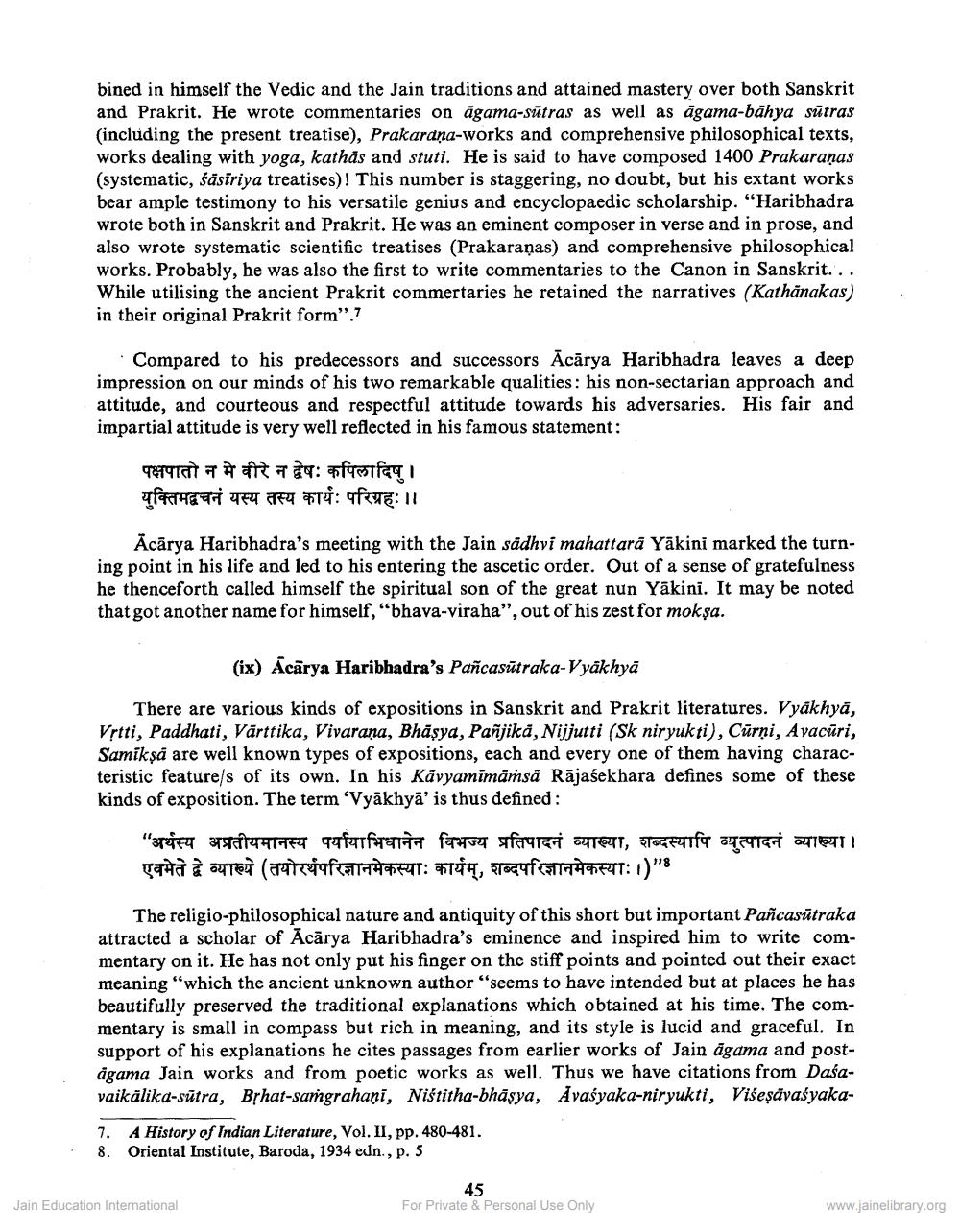________________
bined in himself the Vedic and the Jain traditions and attained mastery over both Sanskrit and Prakrit. He wrote commentaries on agama-sutras as well as agama-bahya sutras (including the present treatise), Prakarana-works and comprehensive philosophical texts, works dealing with yoga, kathas and stuti. He is said to have composed 1400 Prakaranas (systematic, śásiriya treatises)! This number is staggering, no doubt, but his extant works bear ample testimony to his versatile genius and encyclopaedic scholarship. "Haribhadra wrote both in Sanskrit and Prakrit. He was an eminent composer in verse and in prose, and also wrote systematic scientific treatises (Prakarapas) and comprehensive philosophical works. Probably, he was also the first to write commentaries to the Canon in Sanskrit... While utilising the ancient Prakrit commertaries he retained the narratives (Kathānakas) in their original Prakrit form"."
Compared to his predecessors and successors Acārya Haribhadra leaves a deep impression on our minds of his two remarkable qualities: his non-sectarian approach and attitude, and courteous and respectful attitude towards his adversaries. His fair and impartial attitude is very well reflected in his famous statement:
पक्षपातो न मे वीरे न द्वेषः कपिलादिषु ।
युक्तिमद्वचनं यस्य तस्य कार्यः परिग्रहः ।
Acarya Haribhadra's meeting with the Jain sadhvi mahattarā Yākini marked the turning point in his life and led to his entering the ascetic order. Out of a sense of gratefulness he thenceforth called himself the spiritual son of the great nun Yakini. It may be noted that got another name for himself, "bhava-viraha", out of his zest for mokşa.
(ix) Acarya Haribhadra's Pañcasūtraka-Vyakhyā
There are various kinds of expositions in Sanskrit and Prakrit literatures. Vyakhyā, Vrtti, Paddhati, Värttika, Vivarana, Bhāṣya, Pañjika, Nijjutti (Sk niryukti), Carni, Avacāri, Samikså are well known types of expositions, each and every one of them having characteristic feature/s of its own. In his Kavyamimāṁsā Rājasekhara defines some of these kinds of exposition. The term 'Vyakhyā' is thus defined:
"अर्थस्य अप्रतीयमानस्य पर्यायाभिधानेन विभज्य प्रतिपादनं व्याख्या, शब्दस्यापि व्युत्पादनं व्याख्या । एवमेते द्वे व्याख्ये ( तयोरर्थपरिज्ञानमेकस्याः कार्यम्, शब्दपरिज्ञानमेकस्याः । ) 8
The religio-philosophical nature and antiquity of this short but important Pañcasūtraka attracted a scholar of Acarya Haribhadra's eminence and inspired him to write commentary on it. He has not only put his finger on the stiff points and pointed out their exact meaning "which the ancient unknown author "seems to have intended but at places he has beautifully preserved the traditional explanations which obtained at his time. The commentary is small in compass but rich in meaning, and its style is lucid and graceful. In support of his explanations he cites passages from earlier works of Jain agama and postagama Jain works and from poetic works as well. Thus we have citations from Dasavaikālika-sutra, Brhat-samgrahanl, Nistitha-bhäşya, Avasyaka-niryukti, Višesavasyaka
7. A History of Indian Literature, Vol. II, pp. 480-481. 8. Oriental Institute, Baroda, 1934 edn., p. 5
Jain Education International
45
For Private & Personal Use Only
www.jainelibrary.org




